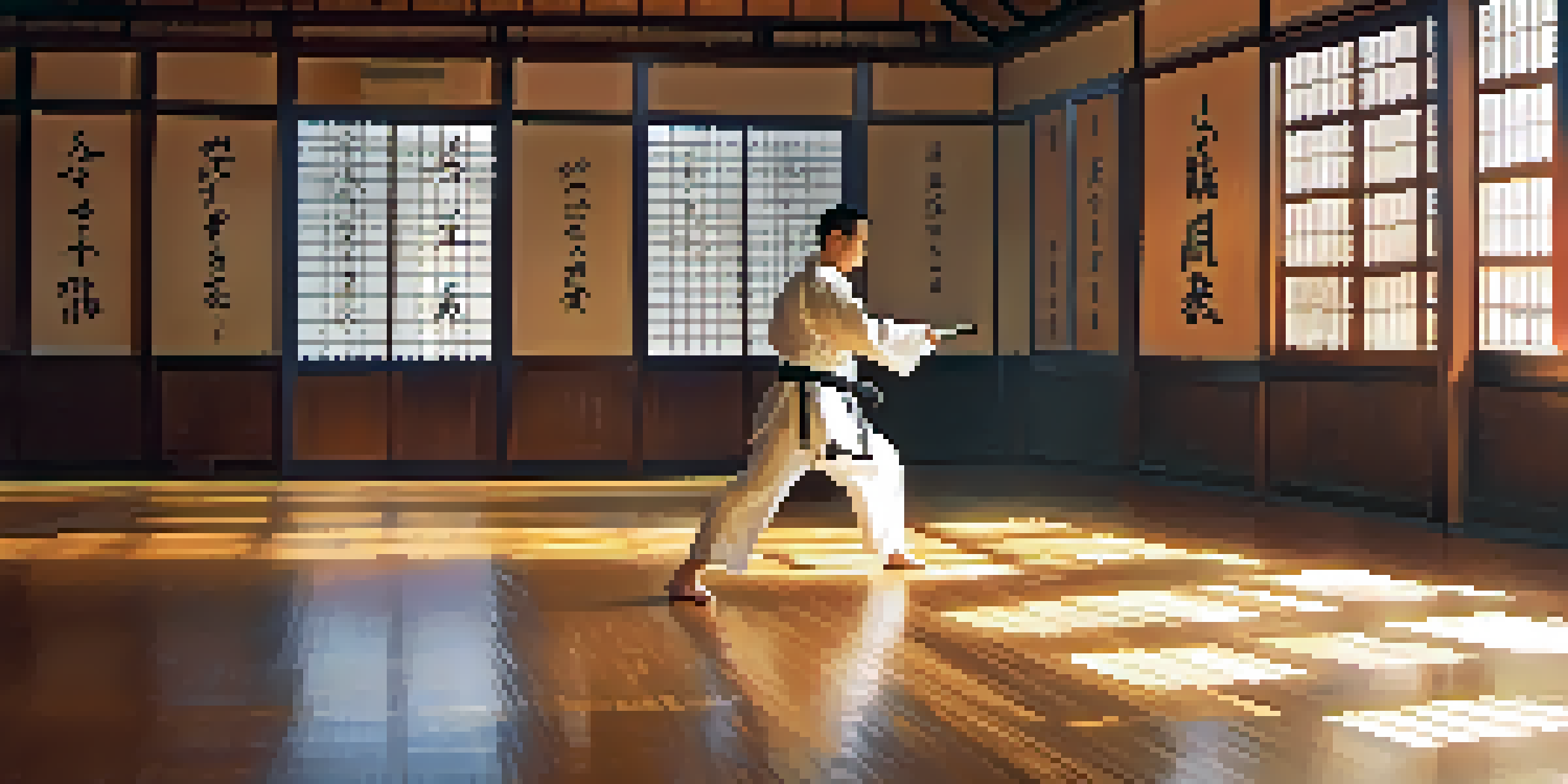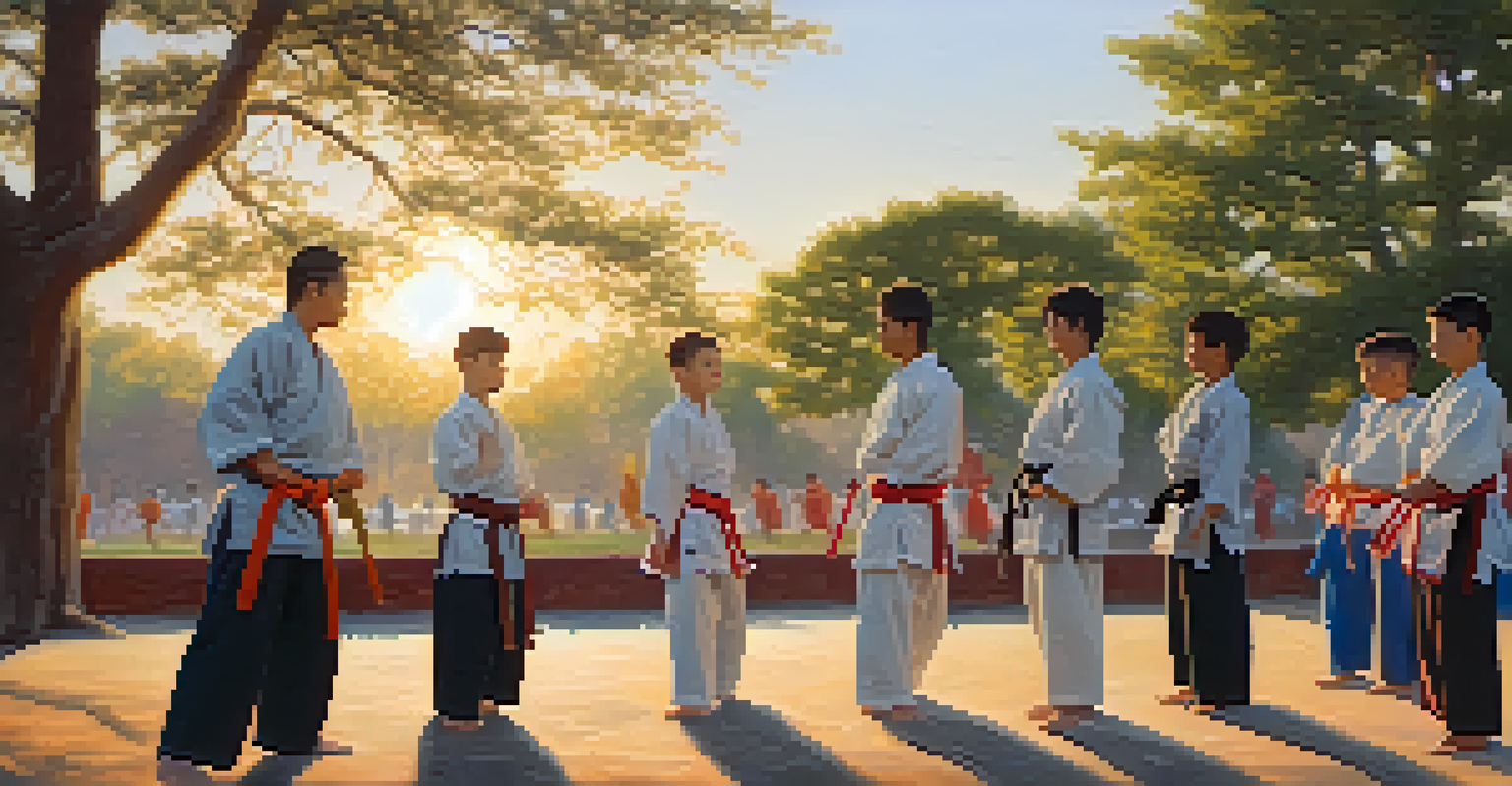Finding Calm: How Martial Arts Cultivate Inner Peace

Understanding the Connection Between Martial Arts and Peace
Martial arts often evoke images of intense physical combat, but at their core, they emphasize inner tranquility. The practice involves a deep focus on breathing, movement, and mental clarity, all of which contribute to a calming effect on the mind. This connection between physical discipline and mental peace is what draws many individuals to martial arts as a form of personal development.
The ultimate aim of martial arts is not having to use them.
For instance, during a typical class, practitioners engage in various forms of meditation and breathing exercises that help center their thoughts. This structured approach allows individuals to let go of outside distractions and immerse themselves in the present moment. It's as if each punch or kick becomes a tool for not just physical strength, but also mental serenity.
Ultimately, understanding this fundamental link can transform how we perceive martial arts—not merely as a form of self-defense but as a pathway to achieving inner calm.
The Role of Mindfulness in Martial Arts Training
Mindfulness is a key element in martial arts that encourages practitioners to live in the moment. Each movement, whether it’s a kick or a block, demands complete attention, which naturally leads to a meditative state. This focus helps to quiet the mind, reducing stress and anxiety as students learn to control their thoughts and emotions.

For example, when a martial artist practices a kata, a series of choreographed movements, they must concentrate fully on their form and technique. This immersion allows them to forget about daily stresses and worries, creating a mental space that fosters peace. Over time, this practice of mindfulness can seep into other areas of life, promoting a more relaxed approach to challenges.
Martial Arts Cultivates Inner Peace
The practice of martial arts emphasizes mental tranquility through mindfulness, breathing techniques, and physical discipline.
Thus, the discipline of mindfulness within martial arts not only enhances performance but also cultivates a lasting sense of tranquility.
Breathing Techniques: The Heart of Martial Arts Calm
Breathing techniques are a fundamental part of martial arts that contribute significantly to achieving inner peace. Controlled breathing helps to regulate the body’s response to stress and anxiety, promoting a state of relaxation. Instructors often emphasize the importance of deep, rhythmic breathing to help students maintain focus and calm during practice.
In martial arts, you can only grow through overcoming challenges.
For instance, practitioners might use specific breathing patterns during meditation or while executing techniques. This practice not only enhances physical performance but also serves as a tool for emotional regulation. As they learn to control their breath, students often find they can better manage their reactions in high-pressure situations.
In essence, mastering breathing techniques empowers martial artists to cultivate a sense of calm that extends beyond the dojo into everyday life.
The Physicality of Martial Arts and Its Calming Effects
Engaging in physical activities like martial arts can paradoxically lead to a state of inner peace. The rigorous training and workouts release endorphins, which are natural mood lifters, making participants feel more relaxed and at ease. This physical exertion not only strengthens the body but also serves as a release valve for pent-up stress.
Imagine the feeling after a long training session: the exhaustion mixed with satisfaction brings a sense of clarity and calm. As martial artists push their limits, they often experience a catharsis that helps them let go of negative emotions. This release can be incredibly therapeutic and fosters an overall sense of well-being.
Community Enhances Emotional Support
Training alongside others fosters connections and provides a support network that alleviates feelings of isolation.
Therefore, the physicality of martial arts is not just about building strength; it also plays a crucial role in enhancing mental peace.
Community and Support: Building Bonds Through Martial Arts
The sense of community formed in martial arts schools can greatly contribute to an individual's inner peace. Training alongside others fosters connections and friendships, which can be a vital source of support. This camaraderie provides a safe space for individuals to share their struggles and experiences, creating a network of understanding.
Participating in group classes or sparring sessions allows practitioners to feel a sense of belonging. This shared journey towards self-improvement can alleviate feelings of isolation and anxiety. Knowing that others are navigating similar challenges can be incredibly reassuring and calming.
Ultimately, the bonds formed in martial arts can enhance emotional resilience, making it easier to find peace in both practice and life.
Discipline and Patience: Keys to Inner Peace
Martial arts instills a sense of discipline and patience in its practitioners, both of which are essential for cultivating inner peace. The journey to mastering techniques takes time and perseverance, teaching individuals the value of persistence. This understanding helps to develop a mindset that appreciates gradual progress rather than instant results.
For example, beginners may struggle with basic moves, but through consistent practice, they gradually improve their skills. This process fosters patience and encourages a reflective approach to challenges. With each small victory, practitioners learn to celebrate progress, which contributes to a more peaceful outlook on their journey.
Discipline Builds Patience and Resilience
The journey of mastering martial arts teaches practitioners the value of patience and resilience, essential for achieving inner calm.
In this way, the discipline of martial arts becomes a profound teacher of patience, guiding individuals toward a calmer state of mind.
Lessons in Resilience: Overcoming Challenges for Inner Peace
Martial arts training often involves facing and overcoming various challenges, which can significantly enhance inner peace. Each obstacle, whether physical or mental, provides an opportunity for growth and self-discovery. By learning to confront difficulties in a safe environment, practitioners develop resilience that translates into everyday life.
Consider the experience of sparring with a partner: it requires quick thinking and adaptability. Successfully navigating these challenges builds confidence and reinforces the belief that one can handle whatever life throws their way. This newfound resilience is crucial for maintaining calm in stressful situations outside the dojo.

Thus, the lessons learned through martial arts serve not only to strengthen the body but also to fortify the mind against life's uncertainties.